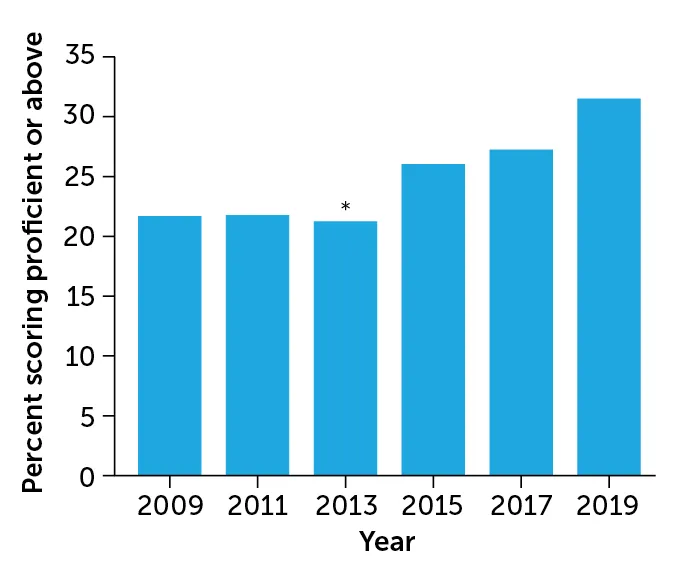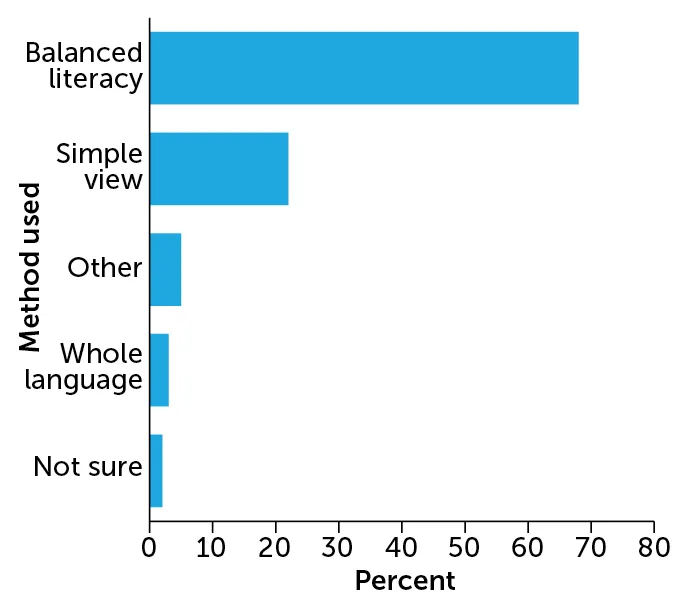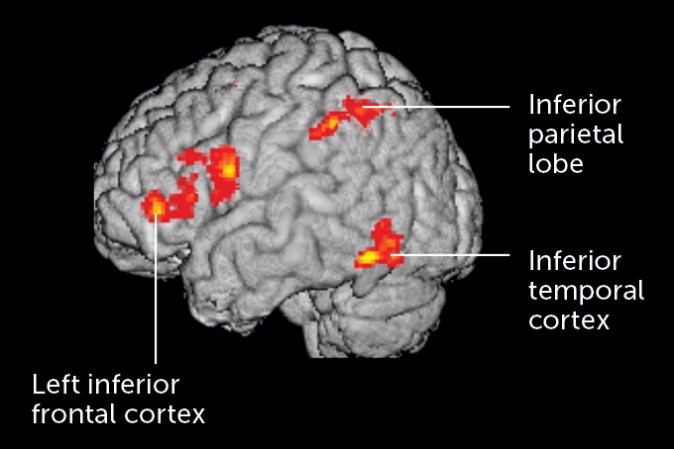
Many U.S. teachers are not using the most science-based approaches to teach reading.
Ariel Skelley/DigitalVision/Getty Images
On a chilly Tuesday back in January, my 7-year-old son’s classroom in Minneapolis was humming with reading activities. At their desks, first- and second-graders wrote on worksheets, read independently and did phonics lessons on iPads. In the hallway, students took turns playing a dice game that challenged them to spell out words with a consonant-vowel-consonant structure, like wig or map.
In another part of the classroom, small groups of two or three children, many missing their two front teeth, took turns sitting on a color-block carpet with teacher Patrice Pavek. In one group, Pavek asked students to read out loud from a list of words. “Con-fess,” said a dimpled 7-year-old named Hazel, who sat cross-legged in purple boots and a black fleece. Pavek reminded Hazel that a vowel sound in the middle of a word changes when you put an e at the end. Hazel tried again. “Con-fuse,” she said. “Beautiful!” Pavek beamed.
When Hazel returned to her desk, I asked her what goes through her mind when she gets to a word she doesn’t know. “Sound it out,” she said. “Or go to the next word.” Her classmates offered other tips. Reilly, age 6, said it helps to practice and look at pictures. Seven-year-old Beatrix, who loves books about unicorns and dragons, advocated looking at both pictures and letters. It feels weird when you don’t know a word, she said, because it seems like everyone else knows it. But learning to read is kind of fun, she added. “You can figure out a word you didn’t know before.”
Like the majority of schools in the United States, my son’s district uses an approach to reading instruction called balanced literacy. And that puts him and his classmates in the middle of a long-standing debate about how best to teach children to read.
The debate — often called the “reading wars” — is generally framed as a battle between two distinct views. On one side are those who advocate for an intensive emphasis on phonics: understanding the relationships between sounds and letters, with daily lessons that build on each other in a systematic order. On the other side are proponents of approaches that put a stronger emphasis on understanding meaning, with some sporadic phonics mixed in. Balanced literacy is one such example.
The issues are less black and white. Teachers and reading advocates argue about how much phonics to fit in, how it should be taught, and what other skills and instructional techniques matter, too. In various forms, the debate about how best to teach reading has stretched on for nearly two centuries, and along the way, it has picked up political, philosophical and emotional baggage.
In fact, science has a lot to say about reading and how to teach it. Plenty of evidence shows that children who receive systematic phonics instruction learn to read better and more rapidly than kids who don’t. But pitting phonics against other methods is an oversimplification of a complicated reality. Phonics is not the only kind of instruction that matters, and it is not the panacea that will solve the nation’s reading crisis.
Cutting through the confusion over how to teach reading is essential, experts say, because reading is crucial to success, and many people never learn to do it well.
According to U.S. government data, only one-third of fourth-graders have the reading skills to be considered proficient, which is defined by the National Assessment of Educational Progress as demonstrating competency over challenging subject matter. And a third of fourth-graders and more than a quarter of 12th-graders lack the reading skills to adequately complete grade-level schoolwork, says Timothy Shanahan, a reading researcher at the University of Illinois at Chicago.
Those struggles tend to persist. As many as 44 million U.S. adults, or 23 percent of the adult population, lack literacy skills, according to U.S. Department of Education data. Those affected may be able to read movie listings, or the time and place of a meeting, but they can’t synthesize information from long passages of text or decipher the warnings on medication inserts. People who can’t read well are less likely than others to vote, or read the news or secure employment. And today’s technology-based job market means students need to achieve more with reading than in the past, Shanahan says. “We are failing to do that.”

Trustworthy journalism comes at a price.
Scientists and journalists share a core belief in questioning, observing and verifying to reach the truth. Science News reports on crucial research and discovery across science disciplines. We need your financial support to make it happen – every contribution makes a difference.
Lessons in decoding
The vast majority of children need to be taught how to read. Even among those with no learning disabilities, only an estimated 5 percent figure out how to read with virtually no help, says Daniel Willingham, a psychologist at the University of Virginia in Charlottesville and author of Raising Kids Who Read. Yet educators have not reached consensus on how best to teach reading, and phonics is the part of the equation that people still argue about most.
The idea behind a systematic phonics approach is that children must learn how to translate the secret code of written language into the spoken language they know. This “decoding” begins with the development of phonological awareness, or the ability to distinguish between spoken sounds. Phonological awareness allows children, often beginning in preschool, to say that big and pig are different because of the sound at the beginning of the words.
Once children can hear the differences between sounds, phonics comes next, offering explicit instruction in the connections between letters, letter combinations and sounds. To be systematic, these skills need to be taught in an organized order of concepts that build on one another, preferably on a daily basis, says Louisa Moats, a licensed psychologist and literacy expert in Sun Valley, Idaho. Today, phonics proponents often advocate for the simple view of reading, which emphasizes decoding and comprehension, the ability to decipher meaning in sentences and passages.
Support for phonics has been around since at least the 1600s, but critics have also long expressed concerns that rote phonics lessons are boring, prevent kids from learning to love reading and distract from the ability to understand meaning in text. In the 1980s, this kind of thinking led to the rise of whole language, an approach aimed at making reading joyful and immersive instead of mindless and full of effort.
By the 2000s, a more all-around and phonics-inclusive approach called balanced literacy was gaining popularity as the leading theory in competition with phonics-first approaches.
In a 2019 survey of 674 early-elementary and special education teachers from around the United States, 72 percent said their schools use a balanced literacy approach, according to the Education Week Research Center, a nonprofit organization in Bethesda, Md. The implementation of balanced literacy, however, varies widely, especially in how much phonics is included, the survey found. That variation is probably preventing lots of kids from learning to read as well as they could, decades of research suggests.
In the late 1990s, with the reading wars in full swing, the National Institute of Child Health and Human Development brought together a panel of about a dozen reading experts to evaluate the evidence for how best to teach reading. The National Reading Panel’s first task was to figure out which types of teaching tasks to include in the analysis, says Shanahan, a panel member. Ultimately, the group chose eight categories and conducted a meta-analysis of 38 studies involving 66 controlled experiments from 1970 through 2000. The results showed support for five components of reading instruction that helped students the most.
Five essentials
A meta-analysis of 38 studies found five components of reading instruction were most helpful to students.
Phonemic awareness
Knowing that spoken words are made of smaller segments of sound called phonemes
Phonics
The knowledge that letters represent phonemes and that these sounds can combine to form words
Fluency
The ability to read easily, accurately, quickly and with expression and understanding
Vocabulary
Learning new words
Comprehension
The ability to show understanding, often through summarization
Source: National Reading Panel
Two components that rose to the top were an emphasis on phonemic awareness (a part of phonological awareness that involves the ability to identify and manipulate individual sounds in spoken words) and phonics. Studies included in the analysis showed that higher levels of phonemic awareness in kindergarten and first grade were predictors of better reading skills later on. The analysis couldn’t assess the magnitude of benefits, but children who received systematic phonics instruction scored better on word reading, spelling and comprehension, especially when phonics lessons started before first grade. Those children were also better at sounding out words, including nonsense words, Shanahan says.
Vocabulary development was another essential component, as was a focus on comprehension. The final important facet was a focus on achieving fluency — the ability to read a text quickly, accurately and with proper expression — by having children read out loud, among other strategies.
Even before the panel released its results in 2000, numerous studies and books from as early as the 1960s had concluded that there was value in explicit phonics instruction. Studies since then have added yet more support for phonics.
In 2008, the National Early Literacy Panel, a government-convened group that included Shanahan, considered dozens of studies on phonological awareness (including phonemic awareness) plus phonics instruction in preschool and kindergarten. Children who got decoding instruction scored substantially better on tests of phonological awareness compared with those who didn’t. The benefit was equivalent to a jump from the 50th percentile to the 79th percentile on standardized tests, suggesting those students were better prepared to learn how to read.
Likewise, a 2007 meta-analysis of 22 studies conducted in urban elementary schools found that minority children who received phonics instruction scored the equivalent of several months ahead of their minority peers on several academic measures. Studies have not addressed whether phonics might help close demographic achievement gaps, but research suggests that whole language approaches are less effective in disadvantaged populations than in other groups.
“There are several thousand studies at least that converge on this finding,” Moats says. “Phonics instruction has always had the edge in consensus reports.”
It is difficult to quantify how substantial the gains are from explicit phonics instruction, partly because the bulk of published research is full of ambiguities. Randomized trials are rare. Studies tend to be small. And in schools where teachers have autonomy to respond to students at their discretion, control groups are often not well-defined, making it hard to tell what phonics-focused programs are really being compared with, or how much phonics the control groups are getting. The reality of instruction can differ from classroom to classroom, even within the same school. And students who aren’t getting intensive phonics at school may have the blanks filled in at home, where parents might sound out words and talk about letters while reading bedtime stories.
The data that are available suggest that kids who get systematic phonics lessons score the equivalent of about half a grade level ahead of kids in other groups on standardized tests, Shanahan says. That’s not a giant leap, but it helps. “Overwhelmingly in studies, both individually and in a meta-analysis where you’re combining results across studies, if you explicitly teach phonics for some amount of time, kids do better than if you don’t pay much attention to that or if you pay a little bit of attention to [phonics],” he says.
Real experiences
Some of the most compelling evidence to support a phonics-focused approach comes from historical observations: When schools start teaching systematic phonics, test scores tend to go up. As phonics took hold in U.S. schools in the 1970s, fourth–graders began to do better on standardized reading tests.
In the 1980s, California replaced its phonics curriculum with a whole language approach. In 1994, the state’s fourth-graders tied for last place in the nation: Less than 18 percent had mastered reading. After California re-embraced phonics in the 1990s, test scores rose. By 2019, 32 percent achieved grade-level proficiency.
Those swings continue today. In 2019, Mississippi reported the nation’s largest improvement in reading scores; the state had started training teachers in phonics instruction six years earlier. For the first time, Mississippi’s reading scores matched the nation’s average, with 32 percent of students showing proficiency, up from 22 percent in 2009, making it the only state to post significant gains in reading in 2019.
England, too, started seeing dramatic results after government-funded schools were required in 2006 to teach systematic phonics to 5- to 7-year-olds. When the country implemented a test to assess phonics skills in 2012, 58 percent of 5- and 6-year-olds passed. By 2016, 81 percent of students passed. Reading comprehension at age 7 has risen, and gains seem to persist at age 11. These population trends make a strong case for teaching phonics, says Douglas Fuchs, an educational psychologist at Vanderbilt University in Nashville.
A boost with phonics
After adding explicit phonics instruction statewide in 2013, Mississippi reported the nation’s largest improvement in reading scores among fourth-graders.
Mississippi fourth-grade reading proficiency

Source: National Assessment of Educational Progress 2019
Despite the evidence that children learn to read best when given systematic phonics along with other key components of a literacy program, many schools and teacher-training programs either ignore the science, apply it inconsistently or mix conflicting approaches that could hinder proficiency. In the 2019 Education Week Research Center survey, 86 percent of teachers who train teachers said they teach phonics. But surveyed elementary school teachers often use strategies that contradict a phonics-first approach: Seventy-five percent said they use a technique called three cuing. This method teaches children to guess words they don’t know by using context and picture clues, and has been criticized for getting in the way of learning to decode. More than half of the teachers said they thought students could understand written passages that contained unfamiliar words, even without a good grasp of phonics.
The disconnect starts at the top. In a 2013 review of nearly 700 teacher-training institutions, only 29 percent required teachers to take courses on four or five of the five essential facets of reading instruction identified by the National Reading Panel. Almost 60 percent required teachers to complete coursework on two or fewer of the essentials, according to the National Council on Teacher Quality, a research and policy group based in Washington, D.C.
Teacher’s choice
In a random sample of almost 700 U.S. early-elementary and special education teachers, most reported using a method called balanced literacy to teach reading. The simple view of reading, focused on phonics, was a distant second.
Balanced literacy
Instruction includes a bit of everything, usually with some phonics.
Simple view
The emphasis is on phonics, with a focus on two skills: decoding and language comprehension.
Whole language
Instruction emphasizes whole words and phrases in meaningful contexts, including a strategy called three cuing.
How U.S. educators teach reading

Source: EdWeek Research Center 2020
In 2019, the Education Week Research Center also surveyed 533 postsecondary educators who train teachers on how to teach reading. Only 22 percent of those educators said their philosophy was to teach explicit, systematic phonics. Almost 60 percent said they support balanced literacy. And about 15 percent thought, contrary to evidence, that most students would learn to read if given the right books and enough time.
“The majority of classrooms in this country continue to embrace instructional practices and programs that do not include systematic instruction in foundational skills like phonemic awareness and phonics and spelling,” Moats says. “They just don’t do it.”
At my son’s Minneapolis school, reading specialist Karin Emerson told me about her early days teaching kindergarten, first and second grades in the 1990s. She was trained to use a whole language approach that included the three cuing technique.
Emerson described a typical reading lesson: “I’m going to show you a big book, and I’m going to cover up all of the letters of the word except the b, and I’m going to say, ‘Look at this page. It says this is a …’ What do you think it’s going to say?” Then she would point out the butterfly in the picture and ask the students to think about whether the b sound could refer to anything in the picture. “What does butterfly start with? A ‘b-uh.’ Do you think it’s going to be butterfly? I think it is going to be butterfly. It is.”
Eight years later, Emerson switched from classroom teacher to reading specialist, helping third-graders who weren’t reading yet. Many were the same students she had taught to read in younger grades. After reviewing the reading research, she implemented systematic phonics. By the end of third grade, students in her groups advanced an average of two grade levels. She now encourages early-grade teachers to add at least 20 minutes of phonics a day into literacy lessons.
Looking back to her classroom-teaching days, Emerson says parents often told her they were concerned that their children weren’t reading yet. “I would say, ‘Oh, they’ll be fine because they’re well spoken, they’re bright and you’re reading to them.’ Well they weren’t fine,” Emerson says. “Some people learn how to read super easy, and that’s great. But most people need to be taught, and there’s a pretty big chunk who need to be taught in a systematic way.”
While learning about ongoing battles over reading instruction, I have been marveling at my son’s transformation from nonreader to reader. One recent afternoon, he came home from school and told me that he had learned how to spell the word “A-G-A-I-N.” I asked him how he would spell it if it looked like it sounded. He worked it out, one sound at a time: “U-G-E-N.” We agreed the English language is pretty strange. It’s amazing anyone learns to read it at all.
This is your brain on reading
Reading is a relatively new activity for the human brain, which hasn’t had time to evolve specialized areas devoted to the task. Instead, our brains enlist areas, such as the visual system, that originated for other reasons, says Guinevere Eden, a neuroscientist at Georgetown University in Washington, D.C. An object like a tree or a lion needs to be recognizable from any angle, she says. But when we read, we need to override that kind of pattern recognition to distinguish, say, b from d, two letters that look identical to a beginning reader.
To translate squiggles and dots into sounds, several key brain areas, in both the visual and language systems, get involved. And how involved those areas are during reading shifts with increasing mastery, according to brain-imaging studies from the last two decades. When early or experienced readers sound out an unfamiliar word, they tap into the posterior and superior temporal lobes and inferior parietal lobe, which are involved in language and sensory processing. When the brain encounters a familiar word, on the other hand, the visual cortex takes over, suggesting that known words become like any other object that the brain recognizes instantly. As a person’s reading skills improve and the mental menu of familiar words grows, activity is more pronounced in the visual cortex during reading, Eden says.

Eden uses brain scans to understand what goes wrong in children with reading disabilities, who have trouble sounding out words. One of her goals is to evaluate interventions for children with dyslexia to see if the interventions target the brain processes that are most impaired.
Despite heavy marketing by companies that sell reading products using brain scans as evidence that the companies’ methods help children learn to read, Eden says that imaging studies cannot yet answer questions about which types of reading instruction are best for children, with or without reading disabilities.







